
Handling digital documents have become a part of the daily lives of users. We have seen a lot of Document editing tools and most of them follow the WYSIWYG (‘What you see is what you get’) approach to Word formatting. In such type of Word formatting, a GUI based approach is established and users can visualise the end result while typing out content. The biggest example of this type of document editing system is the Microsoft Word, an app most of us are familiar with.That is one way of approaching Word Formatting. Another way is through the use of a Word formatting tool that makes use of the WYSIWYM (‘What you see is what you mean’) approach. LaTex Editors fall in the second category.
What is a LaTeX editor?
Still don’t get what this is all about? In simple terms, LaTeX (spelled Lay-tek), is a markup level text editing tool that separates the word formatting from the content entry task. Quite similar to HTML in its formatting, LaTeX is one of the most commonly used text editor in the academia. For people having to deal with scientific papers and publishing, with a lot of mathematical equations thrown into the mix, LaTeX text editors are quite the industry standards. These tools allow users to define formatting of text before hand through markup-level instructions and once the content is inserted, the document is ready to be exported as a PDF or any other file format. Mathematical equations are exceptionally handled by these editors and they were the primary reasons leading to its development in the first place.
Best LaTeX Editors You Should Use in 2019
Now that you’ve understood what exactly is the primary purpose of a LaTeX Text editor and how it differs from regular GUI-Based editors, let’s get to our list, shall we?
1. TeXmaker
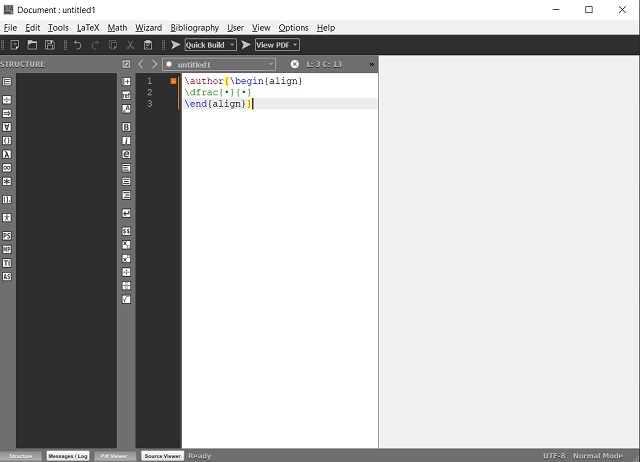
Once the groundwork of your document layout is set up using TeXmaker, the document can now be compiled to get it extracted as a PDF, HTML or ODF file format. Another key feature of TeXmaker is the way it allows users to track errors during the compilation stage. All warnings and errors are displayed to let the user take the needed action regarding the same. Parts/sections of your documents could be easily folded/unfolded using TeXmaker. This tool is also great for creating a structured Bibliography section of your document. Keyboard short-cuts are abundant for TeXmaker and it makes the overall experience with this tool pretty worthwhile.
Key Features: Unicode support, Code folding, Spell-checking, Built-in PDF viewer, Auto-completion, 370 mathematical symbols and more.
Platforms Supported: Windows, Mac OS X and Linux
2. TeXnicCenter
TeXnicCenter is another great LaTeX editor specifically developed for Windows operating system. Since it runs on Windows, TeXnicCenter uses Microsoft’s MiKTeX typesetting distribution which makes it easy for Microsoft Word to process LaTeX documents. Also, TeXnicCenter is a free and open-source LaTeX editor so that’s great. Talking about the features, it has almost everything that you want in a LaTeX editor. You have a powerful GUI editor with support for auto-completion and thousands of UTF-8 character encoding. Along with that, TeXnicCenter follows a master-branch navigator which makes it easy for users to navigate LaTeX documents.
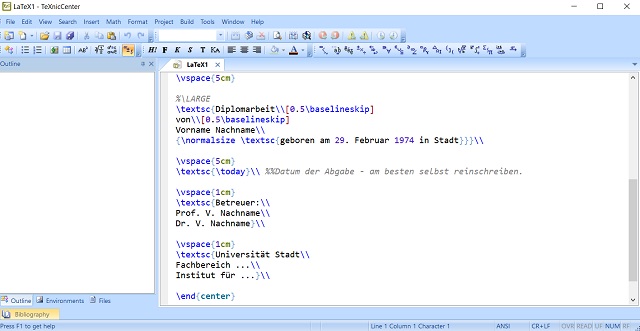
What I love about TeXnicCenter is that it has pre-defined LaTeX snippets which makes it easy to create complex formula and documentation particularly for computer scientists. It goes without saying that TeXnicCenter has all the common features like syntax highlighting, bracket matching and spell checking. To sum up, if you are a Windows user, TeXnicCenter is one of the best LaTeX editors and you don’t have to look any further.
Key Features: Integrated LaTeX environment for Windows apps, Auto-completion, Complete UTF-8 support, Document navigator, Library of LaTeX snippets, Syntax Highlighting, Spell Checking and more.
Platforms Supported: Windows
3. LyX
LyX is among the most popular LaTeX editors right now with support for many modern and unique features. LyX is an open-source editor and it’s available on a number of platform including Windows, macOS, and Linux. It emphasizes on the WYSIWYM writing approach with a simple GUI based interface. It uses many flexible tools like integrated equation editor and reference indexing to create LateX documents seamlessly. While many prefer LyX for mathematical documents, you can also create a structured novel or script using its advanced markup tools. Besides that, you have support for academic article referencing, link overlay and ability to create a master thesis using branched out nodes.
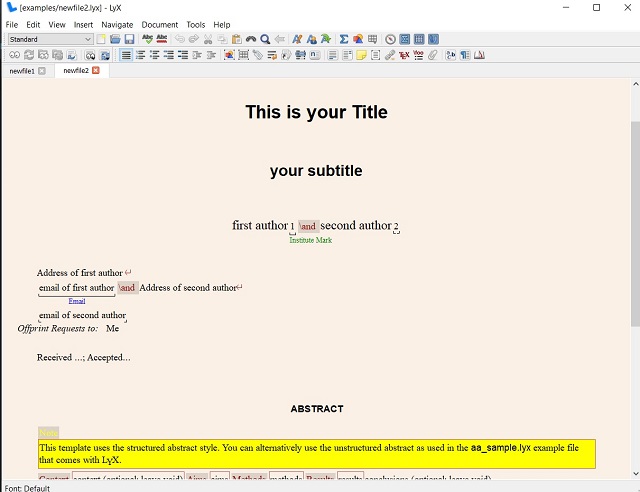
In addition, you can also author scientific papers with reference lists and citations. The automatic index creation is a unique feature that you will only find on LyX. With its advanced mathematical tools, you can visually drag and drop equations and edit them right there. You also have access to many algorithms, theorems, and arrays of equations. Having said that, what I love about LyX is that how easy it’s to create LaTeX documents without worrying about formatting details or design attributes. Simply put, if you are new to LaTeX word processing and want to create scientific documents, opt for LyX and it will take you right home.
Key Features: Visual Mathematical Editor, Auto-completion, BibTeX support for creating a bibliography, Support for many graphic formats like complex graphs and tables, Huge library of mathematical formulae, Spell-checking, PDF viewer and more.
Platforms Supported: Windows, macOS, and Linux.
4. Texstudio
TeXstudio is another open-source and multi-platform LaTeX editor, which is quite popular among the academia. This tool is based on the open-source TeXmaker which we just talked about. TeXstudio is pretty much an extension of the former mentioned tool and added further support and features to it. While the entire interface might pretty much feel similar to TeXmaker, but additional features like Document Word count, frequency count analysis and more made it into an independent full-blown LaTeX editing tool itself.

Some of its key features are Syntax Highlighting, reference checking, multi-cursors and more than 1000 mathematical formula included with it. Citations form a major component of scientific documents and TeXstudio provides support for Link overlay helps a lot in that. The Assistant feature of TeXstudio makes it easy for anyone without the complete knowledge of LaTeX editors set up a file and place blocks of images or tables anywhere in the document. Images could be dragged and dropped into this editor and Table Auto-formatter takes care of adequately formatting your created tables. These are the additional features to TeXstudio, in addition to the regular Structure viewing, Code folding, Spell-checking, Auto-corrections, Syntax highlighting and all the other features that TeXmaker possesses.
Key Features: Auto-completion, Insertion of Tables, Figures, Mathematical formulae, Spell-checking, Built-in PDF viewer, Syntax highlighting, Export to HTML and more.
Platforms Supported: Windows, Mac OS X, Linux and FreeBSD.
5. TeXworks
TeXworks is another multi-platform, open-source LaTeX editor. TeXworks is a LaTeX editing tool that is based off another open-source LaTeX editor – TeXshop. It provides a GUI-based approach to LaTeX editing and features many of the key advantages found in the previous mentioned tools. TeXworks features a built-in PDF viewer just like in the above mentioned tools, but this tool also possesses an auto-synchronization feature to it.
TeXworks features many of the key capabilities of a LaTeX editor like auto-completion, auto-correction, Unicode support and more. If only the basic bare bones of a LaTeX editor is required, It ticks in all the boxes perfectly. This tool although does not feature many of the key features, its minimalist approach to LaTeX editing gets the work done without fussing much about its functionalities. Code folding, Insertion of graphics/tables, interaction with external editors and its powerful built-in PDF viewer and exporter makes this tool one of the best LaTeX editors that the academia often tend to consider.
Key Features: Code folding, auto-completion, auto-correction, Unicode support and built-in PDF viewer.
Platforms Supported: Windows, Mac OS X and Linux
Best online LaTeX editors
6. Papeeria
Papeeria is an online LaTeX editor which is quite good with advanced tools and features. You can achieve all the LaTeX editing features online using its web-based UI. One of the key features of Papeeria is its huge library of templates. Among these templates, there are technical paper layouts, Scientific magazines, journal articles, CV and more. You can simply choose one such layout and get started on editing your content without worrying much about the formatting associated with it.
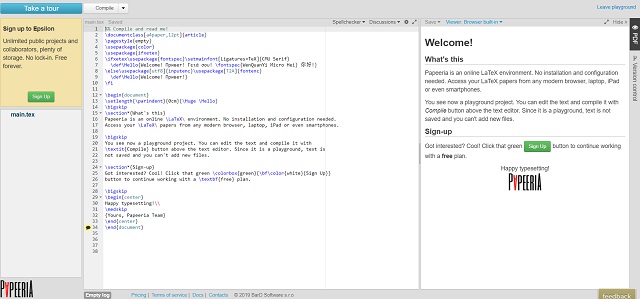
Another great feature of Papeeria is that it allows users to collaborate on a LaTeX document. You can collaborate with other members on your LaTeX document and sync all the changes on either Google Drive, Dropbox or GitHub. You can also build complex plots visually using its plot builder feature. Trusted by many academicians and scientists, Papeeria is a powerful LaTeX editor which can be accessed right from your web browser.
Key Features: Real-time collaboration, Document history, Google Drive, Dropbox and GitHub syncing supported, Huge library of templates, and more.
Platforms Supported: Web-based, Supports all major web browsers.
Pricing: Free (One active LaTeX project), $5/month (Ten active LaTeX projects)
7. Overleaf
Another great online LaTeX editing tool is Overleaf. Trusted by over 200,000 academia worldwide, Overleaf is a great LaTeX editing tool with all the features that make your document creations easy. Overleaf comes with over hundreds of templates ranging from Lab report and Thesis to Resume/CV and formal letters. If starting over fresh isn’t something you’d consider, getting started with one of their many templates is an easy way to develop professionally formatted documents.

Among the key features of Overleaf are the ability to collaborate with your team members on technical papers or academia documents. This real-time collaboration brings transparency to the editing work that is being put in by all the authors involved in its development. Your final document could easily be shared to different social networks and Git account using your custom generated link. Make this link as ‘Read-only’ or ‘Read-and-Write’ depending on the person you are sharing the document with. Mathematical formula insertion is one of the important aspects of LaTeX editors and Overleaf provides a real-time preview of your text as it gets entered. Its Error control and Notation support makes co-authors familiar with WYSIWIG editors easily take up to this tool.
Key Features: Real-time collaborations, Effortless sharing, Real-time previewing, Rich Text Editing, Easy error tracking, Document revision history and more.
Platforms Supported: Web-based, Supports all major web browsers.
Pricing: Free (Only One Collaborator), $15/mo (10 Collaborators), $30/mo (Unlimited collaborators).
8. Authorea
If you are looking for more web-based LaTeX editors, Authorea should be a great option for you. Authorea is a great online LaTeX editor, and possesses many of the great features offered by the previously mentioned tools. Ready-to-use templates, collaboration tools, document revision history, chat feature, auto-creation of references page, easy insertion of images, links, tables, etc., are some of its key features.
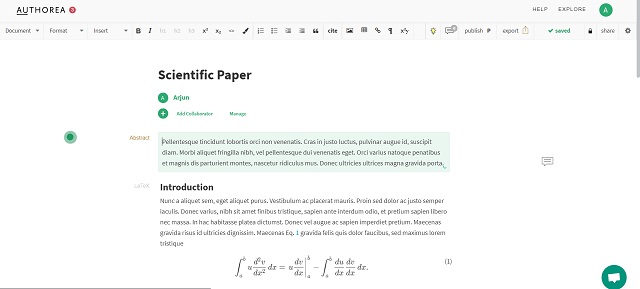
Authorea also supports many file formats including LaTeX, HTML, Markdown and more. Creation of an Index pages, exporting document as PDF, sharing it over social media, quick edit, toggle on/off comments and word count are some of the additional key features of Authorea that makes it one of the best tools for LaTeX editing right from the comforts of your web browser. Insertion of mathematical formula, images and tables is pretty straightforward with Authorea. All in all, its features make Authorea an easy-to-use LaTeX editing tool with no steep learning curve associated with it.
Key Features: Simple insertion of Images, Mathematical formulae, tables and more, Collaborate, Cite papers, Auto-creation of Bibliography, Commenting feature and more.
Platforms Supported: Web-based, Supports all major web browsers
Pricing: Free (Can create up to 3 LaTeX documents; 10 if you are a student or educator), $10/mo (Unlimited LaTeX Documents)
Extensions for LaTeX
9. Vim with LaTeX-Suite
Vim is an open-source and very powerful editor. Vim-LaTeX is an extension for Vim that lets you edit and compile LaTex documents. It brings a minimalist and powerful approach to text editing. Use Vim-LaTeX to bring the best of both the worlds into your document editing processes. The extension works with Vim version 6.0 or above.
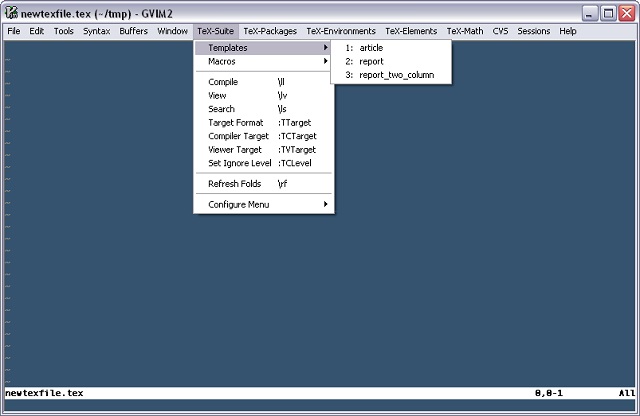
The entire installation process is perfectly documented on their Sourceforge page, which you must definitely pay a visit. There is another standalone Vim software, known as the gVim that brings a GUI-based interface to the Vim document editor. Vim-LaTeX has been developed specifically for the programmers and it is so highly configurable that it can function anyway, ranging from a simple notepad to all kinds of text editing and also editing of configuration files.
Key Features: Visual editing, Mode mapping, Compiling, Error tracking, Code folding, Customized templates and more.
Platforms Supported: Windows, Mac OS X, Linux and Unix-based systems.
10. TeXlipse plugin for Eclipse IDE
If you are a programmer, chances are pretty high that you might have come across the most flexible Eclipse IDE for your development processes. If you are in need of a powerful LaTeX editing tool within your iteration of Eclipse IDE, TeXlipse is a great plugin. TeXlipse brings the best of LaTeX text editing to your Eclipse IDE program. It offers a great WYSIWYM text editor for your programming needs while on Eclipse. Built-in with some of the key features that make up LaTeX editors, TeXlipse is the perfect text editing companion for programmers.
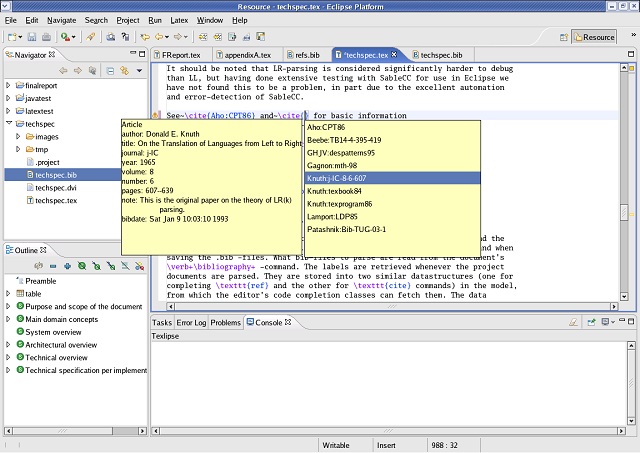
For learning more on how to install TeXlipse on your version of Eclipse IDE, head over to their official website for detailed guide on the process. Some of the key features supported by TeXlipse include code commenting, Code folding, word count, Syntax highlighting and indenting, error markers, document templates and more. Project preview allows users to preview the code output and eliminate any potential problems in the process. A must have add-on for programmers based on Eclipse IDE and looking for a powerful document editing tool to go along with it.
Key Features: Code commenting, Code folding, Table view, Syntax highlighting/indenting, Word count, error markers, Spell checking, Document templates and more.
Platforms Supported: A proper installation of Eclipse IDE on your system.
SEE ALSO: 10 Best Text Editors for Mac
Use These LaTex Editors to Write Your Next Paper
That ends our list of the 10 best LaTex Editors that you should be using in 2019. We have not only include LaTex Editing app but also online LaTex editors along with LaTex plugins. So, you see, you can choose the one that fits your needs. Do check out the list and let us know which is your favorite app to edit LaTex among the all.
from Beebom https://beebom.com/best-latex-editors/


No comments:
Post a Comment